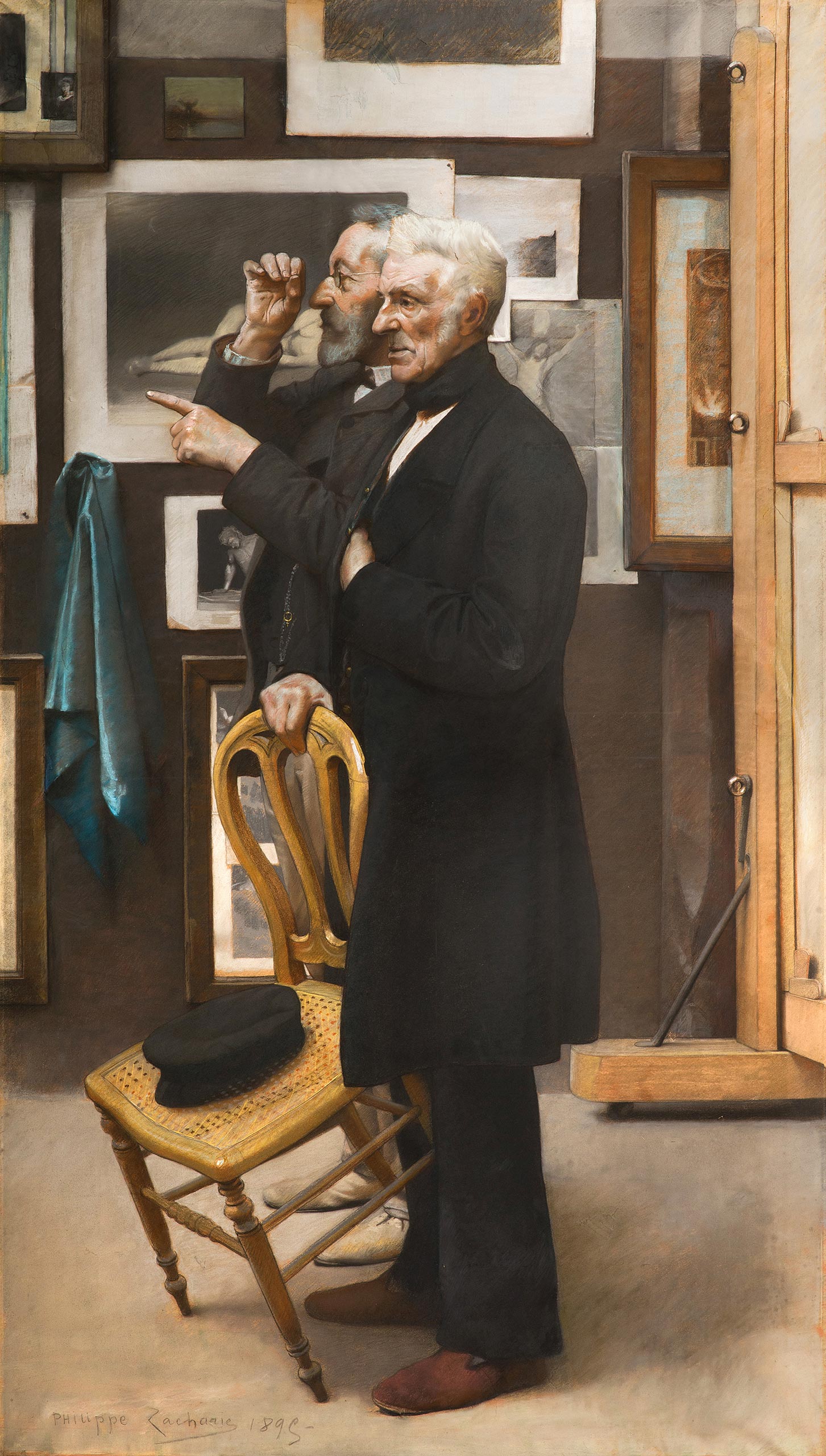
Zacharie
Philippe-Ernest
Radepont (Eure) 1849 — 1915
Les deux connaisseurs
Pastel.
Signé et daté Philippe Zacharie 1895 en bas à gauche.
223 x 124,5 cm (87 13/16 x 49 in.)
Bibliographie
George Dubosc, « Philippe Zacharie », Notre vieux lycée,
Bulletin de l’Association des anciens élèves du lycée de Rouen,
N°32, 1917, p.29.
Philippe Zacharie, qui fit l’essentiel de sa carrière à Rouen, est un peintre peu connu malgré une production assez importante et une participation régulière au Salon de Paris. L’hommage qui lui fut rendu à sa mort par le peintre et journaliste Georges Dubosc demeure la principale source sur la vie et l’œuvre de celui qu’il qualifie de « grand et modeste artiste ». La plupart de ses œuvres sont conservées au musée des Beaux-Arts de Rouen.
Zacharie est formé à l’école municipale de dessin de Rouen par ses professeurs Gustave Morin, connu principalement pour ses dessins de scènes et paysages normands, et Antoine Guillemet, peintre paysagiste lui aussi. Il y rencontre le peintre Albert Lebourg, l’illustrateur Henry Somm et le sculpteur Alphonse Guilloux. À partir de 1870, il envoie des œuvres au Salon de Paris et y participera régulièrement jusqu’en 1914. Il y expose principalement, hormis quelques portraits, des scènes de genre et scènes de la rue parisienne, avec des bouquinistes des concierges, des passants. Ainsi La Femme aux pigeons (Rouen, musée des Beaux-arts) qui obtient en 1883 un franc succès. En 1888, sa Femme au bain est caricaturée dans Le Salon humoristique illustré (p. 11) du Journal amusant. En 1894, son atelier, qui était installé dans le local de l’ancienne école de dessin du musée des antiquités, prend feu ; il perd un grand nombre d’œuvres.
Zacharie se consacre également au portrait ; on connait de lui des portraits au fusain du peintre Albert Lebourg et de sa femme, de l’organiste Marcel Dupré (1886-1971) en 1908, de Jules Adeline, de Georges Dubosc etc. Il apprécie le pastel dont il se sert souvent pour de très grands formats, comme le nôtre ou comme Le Christ expirant conservé au musée des Beaux-Arts de Rouen. Zacharie a également réalisé des peintures murales allégoriques dans des édifices de Rouen, notamment au lycée Corneille dans la salle des actes, ainsi que dans les églises Saint- Clément et Saint-Godard. Il s’exerce aussi à la lithographie ainsi qu’à la pointe sèche et à l’eau-forte. Dubosc décrit ses nombreux dessins à la sanguine mais aujourd’hui, ce sont principalement des dessins au fusain ou au crayon qui nous restent, dont ses portraits ainsi que des scènes de genre proches de celles de François Bonvin, comme par exemple La Récureuse1, Le Coin de cuisine2 ou Le jeune poète3. Il a également réalisé de beaux portraits de femmes à la mine de plomb.
Les deux connaisseurs sont en train d’évaluer la qualité d’un tableau, plus exactement la justesse de ses proportions. Il s’agit sans doute de portraits bien qu’ils ne soient pas identifiés dans la biographie de Georges Dubosc : extrêmement caractérisés, les visages pourront peut-être un jour être identifiés. La scène se passe probablement dans l’atelier de Zacharie. Au mur sont accrochées différentes études qui peuvent lui avoir servi d’études ou de modèles pour ses œuvres. Celle d’une femme allongée, les deux bras vers l’avant peut avoir été utilisée comme modèle pour la femme couchée au sol dans son tableau de 1883, La femme aux pigeons tandis que celle du Christ en croix peut lui avoir servi pour son Christ expirant.
Vendu au Musée des Beaux-arts de Rouen.
- Artcurial, 6 février 2013, lot 69.
- Galerie Hazlitt, Londres, juin 1995.
- Galerie Bailly, Dessins et Esquisses de maîtres anciens et modernes, 17 mai-21 juillet 1989, p. 131, illustré p. 130.

